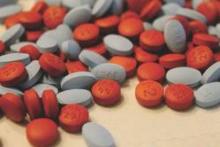Even a short course of NSAIDs markedly raises the risk of major bleeding in patients receiving antithrombotic medication after having a myocardial infarction, according to a report published online Feb. 24 in JAMA.
In a nationwide Danish study, this risk was increased no matter which antithrombotic regimens the participants were taking and no matter which NSAIDs they were given. “There was no safe therapeutic window for concomitant NSAID use, because even short-term (0-3 days) treatment was associated with increased risk of bleeding,” said Dr. Anne-Marie Schjerning Olsen of Copenhagen University Hospital Gentofte, Hellerup (Denmark), and her associates.
More research is needed to confirm the findings of this observational study, but until then “physicians should exercise appropriate caution when prescribing NSAIDs for patients who have recently experienced MI,” they noted.
The only NSAID available over the counter in Denmark during the study period was ibuprofen, and it could only be purchased in low (20-mg) doses and in limited quantities (100 tablets). In countries like the United States, where ibuprofen and other NSAIDs are available without prescriptions and where there are few restrictions on the amounts that can be purchased, these study findings are even more worrying, Dr. Schjerning Olsen and her colleagues said.
Several current guidelines discourage the use of NSAIDs in people with a history of MI, including recommendations from the American Heart Association and the European Medicines Agency. But several sources have indicated that many such patients are being exposed to the drugs. To study the issue, the investigators analyzed data in four nationwide Danish health care registries. They identified roughly 62,000 adults (mean age 67.7 years) hospitalized for recent MI in 2002-2011 and put on antithrombotic medications, of whom nearly 21,000 (33.8%) also received at least one prescription for NSAID treatment.
During a median follow-up of 3.5 years, there were 5,288 major bleeding events in the study cohort, including 799 fatal bleeding events.
The incidence of major bleeding events was 4.2 per 100 person-years among patients given NSAIDs, compared with 2.2 per 100 person-years without NSAID therapy, for a hazard ratio of 2.0. Bleeding risk was markedly increased from the first day of exposure to NSAIDs (HR of 3.37 on days 0-3), and it persisted through 90 days. This pattern was consistent across all antithrombotic regimens and regardless of whether the prescribed NSAIDs were selective COX-2 inhibitors, such as rofecoxib or celecoxib, or nonselective COX-2 inhibitors, such as ibuprofen or diclofenac (JAMA 2015 Feb. 24 [doi:10.1001/jama.2015.0809]).
When major gastrointestinal bleeding events were considered individually, the incidence was 2.1 events per 100 person-years among NSAID users, compared with only 0.8 events per 100 person-years without NSAIDs, for an HR of 2.65. The incidence of combined cardiovascular events was 11.2 per 100 person-years among NSAID users, compared with 8.3 per 100 person-years without NSAIDs, for an HR of 1.4.
These results persisted through several sensitivity analyses. They remained consistent when patients with rheumatoid arthritis were excluded from the analysis; such patients are the primary users of NSAIDs in the age group of the study population. The findings also remained consistent when patients at high risk of bleeding due to comorbidities were excluded from the analysis, including those with malignancy, acute or chronic renal failure, or a history of bleeding events.
“Although it seems unlikely that physicians can completely avoid prescription of NSAIDs, even among high-risk patients, these results highlight the importance of considering the balance of benefits and risks before initiating any NSAID treatment,” Dr. Schjerning Olsen and her associates said.
The study was funded by the Danish Council for Independent Research, the William Harvey Research Institute at Barts, and the London School of Medicine and Dentistry. Dr. Schjerning Olsen reported having no financial conflicts of interest; one of her associates reported ties to Cardiome, Merck, Sanofi, Daiichi, and Bristol-Myers Squibb.

